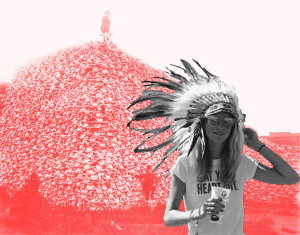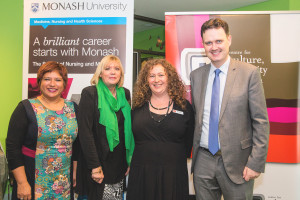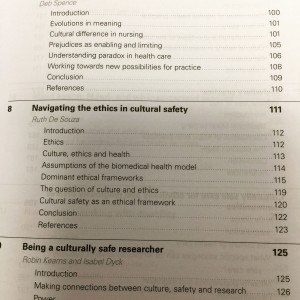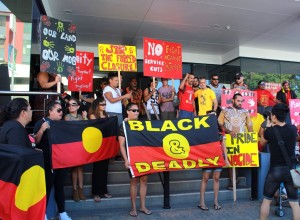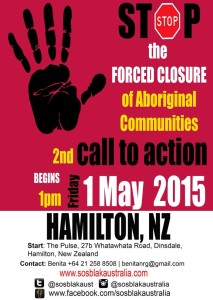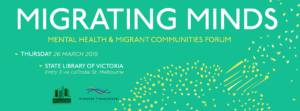Unpublished manuscript that never found an appropriate institutional home, but sharing for those who might be interested. Cite as: DeSouza, R., & Butt, D. (2016, June 11). “I had to keep my options open”: White mothers and neoliberal maternity. [Web log post]. Retrieved from: http://ruthdesouza.dreamhosters.com/2016/06/11/i-had-to-keep-my-options-open-white-mothers-and-neoliberal-maternity/
Where patriarchal healthcare institutions saw birth as a process controlled by male doctors and supported by female nurses, contemporary midwifery draws from liberal feminism the concept of “choice” as the marker of maternal agency. However, critiques of neoliberalism locate “informed choice”, “empowerment” and “partnership” as discursive markers of specific capitalist subjectivities that are unevenly distributed among class, race, and sex. The ideology of reproduction as choice aligns with Foucault’s notion of “governmentality”, where the managerial state promotes middle-class discourses of responsibilisation, transformation and empowerment to regulate and maximise the efforts of individuals within the social body. Previous research has shown how maternal care nurses and midwives are instrumental in reproducing these discourses, reflecting white middle-class ideals of the individual service user. This study explored these themes through a secondary discourse analysis on focus groups with white migrant mothers in Aotearoa New Zealand. While migrant mothers noted differences between the New Zealand context and their home nation, unlike ‘other’ migrant mothers they generally adhered to neoliberal requirements to make choices aligned with the expectations of the state. The mothers espoused ideals of natural birth that sat in tension with their notions of informed consumption, reflecting technoscientific discourses that have informationalised the maternal body and interpellated mothers into neoliberal ideologies. The paper argues that attention to the restricted discourses of choice as empowerment illuminates how settler-colonial maternal healthcare systems are limited in their universality, failing to escape cultural and class-based assumptions that empower some mothers at the expense of others. The paper concludes that critical healthcare analysis and methodologies such as cultural safety provide tools for the transformation of these discourses.
Keywords Maternity, whiteness, neoliberalism, Foucault, cultural safety.
Introduction
Midwifery discourses have advanced a feminist vision of women’s empowerment where women usurp patriarchal control of maternity institutions and increase their own power by becoming informed. However, the intrapersonal strategies of information accumulation and behaviour modification can leave structures of power intact and fulfil neoliberal ends. Facilitating a non-authoritarian, woman-centred ethic of care through liberal feminist values (such as individual choice and autonomy) allows mothers to choose to be healthy and productive, while also leading to a reduction in demands on the state as women govern themselves and each other (Collins, 2009). Although midwifery has positioned itself outside dominant norms as an anti-authoritarian discourse, these ‘choices’ are made within a neoliberal consumerist context of health care (Spoel, 2007). Midwifery is simultaneously constructed by these norms and reproduces them, masking new forms of social regulation shaping health care delivery in the process (Skinner, 1999; Spoel, 2006; O’Connell and Downe 2009). Consequently, the emancipatory promise of liberal feminism has disturbingly converged with the economic ‘freedoms’ of neoliberalism, in a discursive formation structured by whiteness. Where previous work established this formation in the discourses of maternal and child health nurses, this paper diagnoses neoliberal discourses employed by white informed consumers.
The dominance of whiteness in Western healthcare systems has been well established (see e.g. Allen, 2006). The liberal theoretical paradigm is deeply embedded in nursing, where those employed in care are rarely able to see how it structures their professional culture, in turn making it difficult to understand how adherence to seemingly neutral and egalitarian values (to white norms) can be oppressive. Whiteness here does not refer only to the visible phenotype of individuals, but to “a cultural disposition and ideology held in place by specific political, social, moral, aesthetic, epistemic, metaphysical, economic, legal, and historical conditions, crafted to preserve white identity and relations of white supremacy” (Bailey & Zita, 2007: vii). Although it is a scientific and cultural fiction like other racial identities, it has a real social impact on the distribution of resources due to a “possessive investment in whiteness” among white individuals (Lipsitz, 2006). A combination of public policy and private prejudice operate simultaneously to create this investment and perpetuate racialised hierarchies that structure access to resources, power and opportunity. Lipsitz contends that white supremacy is less a direct expression of contempt (as usually described by whites who distance themselves from the term), and more a system that protects white privilege and prevents communities of colour from accumulating assets and upward mobility. Complicating any direct identitarianism, Lipsitz contends that non-white people can become agents of white supremacy as well as passive consumers in its hierarchies— not all white people are equally complicit with white supremacy. White dominance and neoliberalism are two powerful and interrelated concepts that describe the systemic and structural forms that produce and reproduce ideal subjectivities. It is this relationship between subjective experience and institutional rationality that this paper seeks to illuminate.
Liberalism and neoliberal maternity
The revalorisation of liberal precepts into the global structures of institutional power termed neoliberalism has been most thoroughly documented by Michel Foucault. Foucault’s analysis of governmentality as “both a political discourse about the nature of rule and a set of practices that facilitate the governing of individuals from a distance” (Larner, 2006: 6) has particular resonance in health and in maternity. The birth of a future citizen is an event with great emotional, biological, cultural and social significance; and consequently the rites and routines that organize birth reflect core cultural values (Fox & Worts, 1999; Reiger, 2008). Maternal and infant public health has been shaped by state concern about the quantity and quality of population in the context of imperial rivalry, both in the centre of empire and the outer edge of white settlement (Lewis, 1988). The “health of the race” and infant health have been a central focus for doctors and politicians, with babies viewed as valuable assets in the struggle for imperial supremacy (Lewis, 1988). While such explicitly racial discourses are today less prevalent, maternity discourses and practices still reflect and reproduce historical and cultural visions of what it is to be a citizen (Georges, 2008). Good mothering and good governing are intimately linked. Foucauldian analysis in health has shown how institutions produce subjects as citizens, where health professionals are not simply individual agents constrained by institutions but develop their values, beliefs and skills within parameters guided (but not fully determined by) those institutions. Healthcare professionals such as nurses and midwives manage key processes through which hegemonic social subjects are reproduced, and thus reflect transformations in ideologies of the public and the citizenry (Fox & Worts, 1999). Maternal health is therefore a rich site to track shifts in public health from a sovereign technique of population management to a global industry in a neoliberal economic system.
Foucault’s analysis in The Birth of Biopolitics identified neoliberalism as the development of a “general regulation of society by the market” (Foucault, 2008: 145). It involves the enforcement of competition (rather than exchange) as the principle of the market in a game which one is not allowed to drop out of, “a sort of inverted social-contract” (Foucault, 2008: 201). Neoliberal economics becomes “no longer the analysis of the historical logic of processes; it is the analysis of the internal rationality, the strategic programming of individuals’ activity” (Foucault, 2008: 222). In this game, economics is redefined as a behavioural science governed by the “relationship between ends and scarce means which have mutually exclusive uses” (Foucault, 2008: 222). This “competitive ratio” is naturalised, and the neoliberal subject “accepts reality” by responding to “systematic modifications artificially introduced into the environment” — becoming “eminently governable” (Foucault, 2008: 270). Through the extension of market values to all institutions and social action, good neoliberal citizens are constructed as choice-making subjects, who take responsibility for maximising their healthy productivity and minimising risks to their health, reducing collective health demands upon the state.
Historically, women’s freedom during pregnancy was constrained by structural or physical factors to ensure the safety of mother and foetus. Improvements in health have led to the emergence of more subtle kinds of governmental regulation, where normalising strategies focussing on individual ‘lifestyle’ have developed in tandem with the new public health and risk discourses (Petersen & Lupton, 1996). Self-regulation through the internalisation of scientific knowledges and medical technologies and the corresponding modification of behaviour have become central to a type of ideal neoliberal subjectivity variously identified as the healthy citizen (Petersen & Lupton, 1996), the active consumer (Fox, Heffernan, & Nicolson, 2009) and the reflexive project of the self (Giddens, 1991).
Mothers are incited to take up the advice and guidance of experts; are incorporated into relations of surveillance and discipline; and are required to monitor and adapt their behaviour against normative discourses. Ideal neoliberal maternal subjects are scientifically literate, meet normative standards, and consume specialty objects and expert advice (Avishai, 2007). They invest in “intensive motherhood”, a pervasive ideology in Western culture that is: “child-centered, expert-guided, emotionally absorbing, labour intensive, financially expensive” Hays (1998: 46).
As Simon and Dippo (1986: 198) note, a historical and material perspective is required to understand the “nonarbitrary specificity” of power relations in the present, “for while the production and reproduction of social forms is a result of what people do, it can never be understood in terms of what they intend.” To that end, contemporary maternal speech must be linked to the historical conditions of its emergence. The history of midwifery development provides structural clues to the emergence of dominant discursive formations of maternity in New Zealand that enable, constrain and contest the narrated experience of migrant mothers.
Midwifery in New Zealand: erosion, erasure and re-emergence
Midwifery’s emergence as an autonomous feminist profession in New Zealand has been shaped by the desire for professional recognition among midwives and feminist aspirations for the control of birth to be returned to women, (Stojanovic, 2008). Midwifery training began in 1904 with the advent of the Midwives Act, prior to which trained midwives were imported from Britain. Free midwifery services became available to all women from 1938, either in their homes or in maternity hospitals (Pairman, 2006). The trends of medicalisation, hospitalisation and nursification eroded the autonomy of midwifery between 1904 and the 1970s (Stojanovic, 2008). For Māori, the Tohunga Suppression Act (General Assembly of New Zealand, 1907) curtailed the active involvement of tohunga (traditional knowledge specialists) in childbirth, and the expertise of Māori birth attendants or tāpuhi remained suppressed as midwives were trained in New Zealand. With fewer tāpuhi assisting birthing women in their homes, childbirth became relocated into state-owned maternity hospitals, which in the colonial view were thought to be safer and cleaner than Māori homes (Simmonds, 2011), even though Māori maternal mortality rose to three times that of non-Māori by the 1960s. Interventions to reduce infant mortality coupled with demands from women for pain-free childbirth increased the medicalisation of birth, leading to doctors supervising midwifery births and holding legal responsibility (Pairman, 2006). Nursification saw the merging of midwifery into nursing, the erasure of the word ‘midwife’ from legislation and the redefinition of the scope of midwifery practice within nursing (Stojanovic, 2008).
Autonomous midwifery practice (differentiated in scope from nursing) re-emerged through mutually beneficial political lobbying by consumers and midwives forcing legislative changes in the late 1980s. Spurred by decades of feminist struggle, maternity consumer activists saw autonomous midwifery practice as a mechanism for gaining increased control over their own birthing (Pairman, 2006). This pressure eventually led to the passing of the Nurses Amendment Act in 1990 which provided New Zealand women with the option of a caregiver (Lead Maternity Carer or LMC) who could either co-ordinate or provide the care they required from early pregnancy to six weeks postpartum (Pairman, 2006). Consequently, 75.3% of New Zealand women were registered with a midwife to provide lead maternity care in 2007 (Ministry of Health, 2007). Hence, partnership with women became a central tenet of New Zealand midwifery and to its claim as protector of the health of women from an intervening medical corpus (Reiger, 2008). The discourse of ‘partnership’ positions women as ‘naturally’ equipped and capable of carrying and delivering babies without physician monitoring or intervention in hospitals (Macdonald, 2006). The social model of this discourse locates risk not within the female body as under the medical model, but from power relations in the social world including poor support for women. In response, midwives have the capacity to nurture and empower the autonomous woman so that she is capable of birth without intervention (Lane, 2012). The study discussed here consisted of focus groups with mothers and maternal care professionals to evaluate the effects of these discourses and institutional arrangements on different groups of migrant women.
Study Design
The focus groups for this project were undertaken with the assistance of The Royal New Zealand Plunket Society (Plunket), and consisted of focus groups with five ethno-cultural groupings of new migrant mothers (including white mothers) about their maternity experiences (DeSouza, 2006; DeSouza, 2011). Ten first time mothers aged between 29-40 years, who had been living in New Zealand for between two and ten years took part in the white focus group. The women self-identified as ‘white’ and had migrated from South Africa (Jane and Charlotte), England (Nancy, Annette, Olive, Sarah, Carol), the US (Joan and Mary) and Scotland (Georgina). Four had post-graduate qualifications; four had under-graduate qualifications and one a trade certificate. Their occupations included: teacher, scientist, project manager, account manager, project manager, lecturer. Reasons for migrating included the New Zealand lifestyle and their husband’s careers. The group are not intended to be representative of all white female migrants, although the demographic bias of white migrants to New Zealand skews toward the upper-middle class. Of interest here are the range of available subject positions in the discourses represented and what implications those subject positions hold. Discourse analysis can aid understanding of the relationship between “subjectification (the condition of being a subject) and subjectivity (the lived experience of being a subject)” (Walkerdine, 2001: 20). In this case, the focus is on discourses of knowledgeable consumption, natural birth, and intensive motherhood.
Knowledgeable antenatal consumers
Mary invokes liberal feminist/woman centred tenets of choice, freedom and autonomy when she speaks about becoming pregnant through assisted reproductive technologies:
Mary: Artificial insemination… was something that was incredibly easy in New Zealand whereas in the States it would’ve been a lot more difficult and more expensive. For us moving to New Zealand was partly a life-style choice, we had a known donor and we found that we went to a fertility class and it was just incredible how helpful and inclusive they are and everything was really easy to do… more information is always good for us and we found that there was plenty of information for us. It’s like I said before we’ve been planning this for over five years so that was, their resources were there for us.
Mary’s excerpt reflects the liberal feminist ideal of a planned pregnancy and the control of reproductive processes (even in the context of assisted fertility), to which the democratisation of knowledge, its acquisition and demystification are fundamental. Mary positions herself as a responsible health consumer who makes choices (including migrating), within a caring and available system. She actively searches for and chooses the appropriate information, products and services from a saturated global market. Migration is a space where she can realise possibilities for mobility and self-actualisation, imbricating maternity in local and global patterns of consumption. Annette also positions herself as a knowledgeable and responsible consumer, who can both evaluate and challenge expert knowledges:
Annette: Although our doctor suggested certain paths that we could take I wasn’t necessarily in total agreement with what he wanted so I was trying to combine his knowledge with the information that I was reading as well.
Annette’s capacity to act and make choices is evident in her avoidance of informal and embodied knowledge in favour of formal knowledge:
Annette: When I found that I was pregnant the first thing I did was I bought a book named New Zealand Pregnancy Guide… although we have a lot of friends here I didn’t feel that I was in a position where I wanted to talk to anybody about the pregnancy because it was so early and I felt that the more people that I talked to and asked for their advice then if I did miscarry I’d have to tell everybody that I’d miscarried. So I was in that situation of having to try and discover a lot of information out by myself initially and I found that was a little bit overwhelming at times. But that book was particularly useful and then I phoned I think the Ministry of Health and got a list of midwives. And then to be quite honest it was absolutely useless, because I just looked at this list and I’m going, ‘well where do I start’? So you are in this catch 22 thinking ‘do I phone this person? Would they come to me because we’re on the other side of town?’ I didn’t have any recommendations. It was literally a list and it meant nothing to me.
Annette’s preference for purchasing a book of expert knowledge about pregnancy in New Zealand—rather than seeing her networks and friends as primary resources—is emblematic of her desire to produce herself as an autonomous, composed, and rational individual, avoiding public judgement upon her possible failure to reproduce. Her unwillingness to expose her pregnancy and potentially complicate social relationships means that she loses out on possible social support, information and referrals, which could enable the transition to parenthood.
Natural birth
The rewards of antenatal preparation are realised when women describe feeling informed and in control of their birth experiences, aligning with midwifery discourses of natural birth (Brubaker & Dillaway, 2009).
Mary: Well I thought we were going to have a very sort of natural birth with no drugs although I was hoping to take drugs if I was in pain. I found the antenatal explanation of how what happens in a C-section very useful as I ended up having a C-section. And the fact that they explained, ‘ok all of these people are going to be there and it’s going to be a person on your right is going to be your doctor and the person with the baby’, and all of that… I had a really negative reaction to all the drugs and when she explained again who was going to be in the room it was exactly the same as what the antenatal person had said.
Mary’s antenatal preparation equips her for an unintended Caesarean, but instead of feeling cheated by the requirement for medical intervention, she surfaces the woman-centred natural birth discourse of feeling in control and informed. Thus birth can be considered ‘natural’ despite medical intervention, as long as the labouring mother chose the intervention (Macdonald, 2006).
Charlotte’s narrative also captures the two competing discourses of birth that Mary situates herself in. On the one hand, Charlotte values having self-control (through being informed and behaving accordingly) and on the other is willing to surrender control—the choice to rescind action is also a choice (Lupton, 1994):
Charlotte: I just have to say to myself you know we’ve even had to go with the flow, and then also those booklets that you receive on feeding, those pamphlets. I did a lot of reading and my midwife gave me a lot of information. The information from those pamphlets helped me a lot and so I felt comfortable, like I’m on the right track now so everything is going well. So I was trying to speak to myself and keep calm (speaks quietly). I was in labour for since the Saturday and I gave birth on Monday morning so (laughter) I had to keep my options open as well about taking drugs so you know things like that.
Charlotte presents herself as a self-efficacious middle class maternal subject, able to internalise information and adapt her behaviour accordingly through self-discipline, self-denial and will power. Disciplining herself by subsuming her own distress and fear, aligns with the needs of the institution for calm consumers, who are more compliant and require less time and support than distraught ones.
Being given the right information at the right time made Charlotte feel supported:
Charlotte: The midwife that delivered my baby is actually from New Zealand but she worked in Cape Town for three years so that was good, that connection. She told me, step by step where and what stage I’m at. I think that’s the biggest support that you really need in the delivery room is to tell you at what stage you are at and what’s happening.
It is significant that Charlotte constructs her midwife as the person who delivers her baby rather than facilitates Charlotte’s ability to birth her baby. She discursively positions her midwife as a translator, who can link what is happening in her body to an identified physiological process. This positioning challenges midwifery discourses of the mother as ‘expert’ as the midwife’s role as a translator reinforces a hierarchy reminiscent of biomedicine.
Jane actively and discursively resists biomedical discourses, until she acquiesces to Entonox:
Jane: I was trying to still keep my energy up by eating and drinking as much water as possible. My choice was that I wanted to stay at home as long as possible, I didn’t want to be in the hospital for too long because when I start thinking of all the other options, and I wanted a natural childbirth, no assistant and also no pain relief. At the end for about 2 ½ hours before baby was delivered I chose Entonox with the gas and that helped. As the pamphlets also say I actually felt distance from the actual experience so if I think back I would’ve actually chosen nothing but I just felt at that stage I needed something and I chose that. So fortunately baby was in the right position, in a good position so I didn’t have to have a Caesarean. I was more scared of the Caesarean than the pain and I wanted a natural childbirth.
Jane positions herself within midwifery discourses of natural birth, disciplining her body so that she avoids hospital as much as she can, and engaging in deliberate bodily maintenance so she can maximise the efficiency of her body and have the energy to labour. She constructs a natural birth as one where she uses pain relief as a last resort.
Nancy disciplines her body through specific breathing techniques learned outside the health system:
Nancy: Yes. At the beginning of my pregnancy I was kind of really worried about actually giving birth. But what really helped me was I went to do yoga in pregnancy and through that they talked a lot about it and they did sort of breathing and just general exercises to help you kind of keep calm and focused. And at the end of it I really wasn’t worried about it at all and I thought I might even be able to get through this without drugs but I didn’t in the end, I gave in, in the last couple of hours.
Nancy positions herself as a good mother to be, taking control and acting to promote her own health and wellbeing through natural breathing. Nancy’s expectation that her body would be able to cope with birth naturally and without medical intervention reflects her incorporation in woman centred/natural birth discourses. Her acceptance of a biomedical intervention in the form of pain relief in the last few hours is presented as a capitulation, and reflects her perception of the control she had in the process and her failure to accomplish a natural process.
Intensive motherhood
The post-partum period is characterised by the demands of intensive mothering. Producing oneself in the discourses of the “good mother” requires taking sole responsibility for the well-being of the infant while being isolated and having minimal support. The post-natal ward represents a space where the rude transition from women-centred discourses to intensive mothering begins. There is a glaring shift from one-to-one attention from midwives, to competition for support and assistance with other new mothers:
Olive: I mean the actual labour and delivering – fantastic. I couldn’t fault them and the staff was superb, the midwife was just brilliant, the obstetrician fantastic. When I got on the ward I found it really hot, I felt really overwhelmed. I was right next to this buzzer and it just went buzzing all the time because everybody wanted help, I found that really quite distressing and I was absolutely knackered.
The clamour of the buzzer and interruptions signal a consequence of being returned to the factory model of maternity. Olive experiences a shift from care described in superlative terms to feeling overwhelmed, distressed and tired. Meanwhile, Nancy recognises that her expectations were primarily oriented to the birth event with no real preparation for the post-partum period:
Nancy: I just want to say in terms of thinking after the birth, and how it was compared to expectations, I didn’t really have any expectations of after the birth, everything was concentrated about the labour and, ‘oh God, it’s going to feel terrible’ and after the birth it just hit me like that and it was hell for six weeks more or less it was just hell… Yes and I wished somebody had actually told me that it was going to be that hard.
Nancy assumes that if she had been given the information, this post-partum period would have been easier for her, reflecting the notion of autonomous rational personhood that with planning and control of one’s circumstances, future success can be ensured (Wall, 2010).
Interviewer: What was the “hell”?
Nancy: Mainly lack of sleep, lack of sleep and just coping with a crying baby, and I had my Mum and I was lucky she was there for the first three weeks and she did the housework, the cooking and stuff. [Group laughter]
Jane: I also think you also just feel like a robot, cleaning the bottles, making a bottle, breast-feeding, in a little corner all the time, just you and the baby.
The mothers in the group identify a conspiracy of sorts. Much of their preparation for the world of parenthood revolved around knowledge acquisition, maintaining good health during their pregnancies and having control during their labour, none of which help in the postnatal period.
In the quotes that follow, the limitations of expert knowledge and self-sufficiency are identified and Nancy identifies the difference support might make for her.
Nancy: It would’ve been different in that I would’ve had a lot more support and for me a lot of my anxieties around that was I didn’t have anyone to talk to, and particularly (baby crying). And yes OK you meet people at your antenatal group but at that time they’re not your closest friends that you can say anything too. And having said that I did, you know… But I think that was it for me was thinking, ‘oh my God, I just need some adult conversation’. And that’s what I struggled with most probably.
Emotional support and having a confidant require time and energy, and an investment, which can be drawn on. The friendships Nancy has made cannot be drawn on for the kind of support she needs. For Georgina, the absence is emotional as well as practical—in the form of having ‘time out’ for errands or for ‘couple time’:
Georgina: Yes you do miss the support network, friends as well. I’ve got a lot of friends back home who have got kids and I think you miss that as well… Not just family but friends who would maybe be a bit more candour than you might take from them or what you feel than you take from close family and things. So I definitely miss that and also, we were just back home and it was just so nice…you know tight as you are, what simple things, like I needed to go out and do couple of things and I knew I was only going to be half an hour or so and to actually have somewhere to leave him and it would take me half the time.
Discussion and Conclusion
Women who identified as ‘white’ in this study constructed themselves within liberal feminist and neoliberal discourses as consumers who were rational unified actors. They were interpellated as competent selectors and consumers of maternity services, and moral value was attached to their ability to engage in self-reliant behaviours. They embraced the neoliberal psychological imperative to improve and transformed themselves, responding positively even in the most difficult of situations (Baker, 2009). These practices reflect women’s engagement in ‘techniques of the self’ that are constitutive of neoliberal subjectivity. The white mothers conform to the ideal of the good mother (to be) by discursively positioning themselves as taking appropriate individual care and responsibility for their pregnancies and maternal care.
The speech of the women reflects three specific discourses of liberal feminist maternity that form the basis of normative midwifery ideologies.
Firstly, the women routinely position themselves as knowledgeable consumers of authoritative maternity information provided by the health system. Critically interrogating the authority of biomedicine by coordinating and evaluating diverse sources of information is central to woman-centred discourses, where acquiring authoritative knowledge both bypasses medical control and is a way to claim empowerment, subjectivity and agency (Edwards, Davies, & Edwards, 2009). Her ‘preparation’ for motherhood through the acquisition of knowledge valorises scientific/professional knowledge rather than the informal and personalised information or social and emotional support that friends and extended family can provide (Marshall & Woollett, 2000). Authoritative professionals transmit information to individual women whose embodied, enculturated understandings and experiences are discounted or devalued. Yet individual women are expected to engage in reflexive techniques and /or practices of subjectification, to be accountable for the choices that are made, and to account for their behaviours to those who are tasked with monitoring and validated for monitoring them (Stapleton & Keenan, 2009). Thus regulatory technologies “construct an autonomous subject whose choices and desires are aligned with the objectives of the state and other social authorities and institutions” (Petersen & Lupton, 1996: 64).
Secondly, natural birth is positioned as a goal, suppressing technical and industrial discourses associated with medicalisation, except as far as they are in control of the mother. The women articulate being informed and having control, autonomy or authority despite experiencing various degrees of obstetric intervention. As middle-class women are more likely to receive the birth and/or medical treatments they desire, pregnancy and childbirth can be framed as contributing to their personal growth (Brubaker, 2007). In this paradigm of actualisation, it is assumed that intentional actions, self-discipline, self-denial and will power will achieve the ‘right’ kind of birth, and that intervention from a public health system is not a default practice but a considered choice of the mother based on information. In other words, a ‘natural birth’ does not happen naturally, but is chosen as an expression of the knowledgeable consumption discussed above.
Finally, the excerpts on intensive motherhood highlight how this responsibility for maternal self-expression and knowledge is a critical instrument of women’s control in the post-partum period. The mother’s needs are marginalised, as mothers take on most of the responsibility for nurturing and developing the sacred child. Pregnant women and their partners are subject to discipline, given that they are held responsible for maximising their own health and that of their foetus‘ and then infant’s body (Collins, 2009). Intensive mothering is intertwined with a neoliberal rationality, where individual responsibility and self-management are fore-grounded and social support is reduced compared with earlier in the perinatal period (Wall, 2001). Neoliberal discourses place individual responsibility for parenting on mothers, shifting the costs and the burden of work from public resources to household resources. The gendered aspects of these discourses are visible in the assumptions of reproductive heteronormativity, where market production separates the private and public spheres with women taking responsibility for childrearing. These discourses assume that households are based on a nuclear family; that caring labour is divided on the basis of gender, and that this labour is elastic and must expand to fit demand. In turn, the domain of the private is subject to surveillance and regulation to account for responsibilisation, or the ways in which public tasks become the responsibility of individuals, the private sector and community (Schinkel & Van Houdt, 2010; Clarke, 2004). In the postpartum, women note that they are treated like a “normal person”, a labouring, productive figure rather than the choice-making perinatal consumer. The responsibilities for infant care and repetitive ‘robotic’ household tasks seem overwhelming, and there is a sense of failure and disillusionment with the system and with providers that cannot be displaced through their well-developed information gathering strategies.
The interplay of the three discourses has significant implications for maternal mental health, as they locate the “specialness” of birth in decisions which are seen to be under the mother’s individual control, when in fact broader class positions are strongly determinant of what services and support are available. The incentives to locate maternal knowledge in an individual relationship with an authoritative caregiver produce dependence on a system that shifts risk and responsiblity onto the individual. These assumptions come to structure the professional habitus of nursing and midwifery professionals, who adopt regulatory behaviours that fail to support women who do not subscribe to white middle-class ideals. Governing occurs through the aspirations of mothers, and while the state appears to be protecting the interests of infants and parents, little in the way of actual resources are provided. These neoliberal discourses of individual responsibility constructed through dependence on knowledge also disempower women who do subscribe to these ideals, as the institutional withdrawal of support in postnatal care cannot be addressed by the skills the knowledgeable consumer has developed.
Conclusion
In recent decades the capacity of liberal feminist frameworks to provide effective support to non-Western women has been questioned, and midwifery has not been exempt. In New Zealand, the discursive emphasis of being ‘with woman’ implied in the etymology of the word midwife is central to indigenous critiques of Pākeha (white/European) midwifery (Kenney, 2011). Kenney notes that the Pākeha liberal feminist agenda privileges the individual while neglecting the familial context of pregnancy and birth. In contrast, the Māori word for midwife ‘kaiwhakawhānau’ emphasises the facilitation, creation and development of whānau (family). This discursive contrast between Māori models of midwifery has heightened significance in the context of the under-representation of Māori midwives (6.4%) when Māori births comprise approximately 28% of total births and in the context of and inequalities in birth outcomes between Māori and non-Māori (New Zealand Health Information Service 2010 cited in Kenney 2011; Ratima& Crengle, 2012). Midwifery as a profession has attempted to redress these injustices by incorporating Māori cultural principles and values (Ngā Turanga Kaupapa) in midwifery practice competencies (Kenney, 2011), and the development of cultural safety has become a central, if contested tenet of nursing education in New Zealand (Ramsden 1997; DeSouza 2008).
A consistent aim of cultural safety training in nursing has been to deconstruct the implicit racism of the healthcare system, by asking practitioners to reflect on one’s practice, values and cultural assumptions (Browne et al., 2009). In other words, it asks all of us involved in the health system to understand our own position as culture-bearers. Yet, the assumptions of white culture are hard to identify as the norms and commitments of whiteness are naturalised by their ubiquity and dominance. This culture not only shapes practitioner values but also shapes the dominant voices of those consumers who receive and evaluate care, while marginalising women outside these cultural assumptions. Operationalising critical feminist and postcolonial critiques through cultural safety can help nurses understand how the discourses they use are shaped by wider social discourses, which can then be critically interrogated (Browne, 2005). This analysis has aimed to contribute to this project by identifying three norms of white maternity that are normalised in alignment with neoliberal principles: the knowledgeable consumer, natural birth and intensive motherhood. These norms contrast to the discourses that have been identified in the literature on migrant maternity, which generally reflect less of an individualised focus on choosing the experience of birth and more on the presence or exclusion of wider family and social supports. Given the shock and isolation many women experience in the transition from impending mother to intensive mothering, critically advocating for those diverse structures of support can potentially benefit all mothers.
References
Allen DG (2006) Whiteness and difference in nursing. Nursing Philosophy 7(2): 65–78.
Avishai O (2007) Managing the lactating body: The breast-feeding project and privileged motherhood. Qualitative Sociology 30(2): 135-152.
Baker J (2009) Young mothers in late modernity: Sacrifice, respectability and the transformative neo-liberal subject. Journal of Youth Studies 12(3): 275–288.
Browne AJ (2005) Discourses influencing nurses’ perceptions of First Nations patients. Canadian Journal of Nursing Research 37(4): 62–87.
Browne AJ, Varcoe C, Smye V, Reimer-Kirkham S, Lynam M, and Wong S (2009) Cultural safety and the challenges of translating critically oriented knowledge in practice. Nursing Philosophy 10(3): 167–179.
Brubaker SJ and Dillaway HE (2009) Medicalization, natural childbirth and birthing experiences. Sociology Compass 3(1): 31–48.
Clarke J (2004) Dissolving the public realm?: The logics and limits of neo-liberalism. Journal of Social Policy 33(1): 27–48.
Collins EA (2009) Governing partners: responsibilization in pregnancy advice literature for men. Unpublished doctoral thesis. Victoria: University of Victoria.
DeSouza R (2006) New spaces and possibilities: The adjustment to parenthood for new migrant mothers. Wellington: Families Commission.
DeSouza R (2008) Wellness for all: the possibilities of cultural safety and cultural competence in New Zealand. Journal of Research in Nursing 13(2): 125–135.
DeSouza R (2013) Regulating migrant maternity: Nursing and midwifery’s emancipatory aims and assimilatory practices. Nursing Inquiry 20(4): 293-304.
Edwards M, Davies M and Edwards A (2009) What are the external influences on information exchange and shared decision-making in healthcare consultations: A meta-synthesis of the literature. Patient Education and Counseling 75(1): 37–52.
Foucault M (2008) The Birth of Biopolitics: Lectures at the Collège de France 1978-1979. Basingstoke: Palgrave Macmillan.
Fox B and Worts D (1999) Revisiting the critique of medicalized childbirth: A contribution to the sociology of birth. Gender and Society 13: 326-346.
Fox R, Heffernan K and Nicolson P (2009) “I don’t think it was such an issue back then”: Changing experiences of pregnancy across two generations of women in South-East England. Gender, Place & Culture 16(5): 553–568.
Frankenberg R (1993) White women, race matters: The social construction of whiteness. Minneapolis: University of Minnesota Press.
Freda MC (2001) If given the choice. MCN: The American Journal of Maternal/Child Nursing 26(3): 117.
General Assembly of New Zealand (1907) An Act to suppress Tohunga. Statute No: 13. Wellington: Government Print.
Georges E (2008) Bodies of knowledge: The medicalization of reproduction in Greece. Nashville: Vanderbilt University Press.
Giddens A (1991) Modernity and self-identity: Self and society in the late modern age. Stanford: Stanford University Press.
Harvey D (2005) A brief history of neoliberalism. Oxford: Oxford University Press.
Hays S (1998) The cultural contradictions of motherhood. New Haven: Yale University Press.
Hunn JK (1961) Report on the Department of Maori Affairs, with Statistical Supplement, 24 August 1960. Appendices to the Journal of the House of Representatives, G.10. Government Printer, Wellington.
Kenney C (2011) Midwives, women and their families: a Maori gaze. Towards partnerships for maternity care in Aotearoa New Zealand. AlterNative: An International Journal of Indigenous Peoples 7(2).
Lane DK (2012) Dreaming the impossible dream: ordering risks in Australian maternity care policies. Health Sociology Review 21(1): 23–35.
Larner W (2006) Brokering citizenship claims: Neo-liberalism, biculturalism and multiculturalism in Aotearoa. In: E Tastsoglou and AZ Dobrowolsky (eds) Women, migration, and citizenship: Making local, national, and transnational connections. Hampshire: Ashgate, pp. 131–148.
Lewis M (1988) The ‘health of the race’ and infant health in New South Wales: Perspectives on medicine and empire. In: RM MacLeod and MJ Lewis (eds) Disease, medicine, and empire: perspectives on Western medicine and the experience of European expansion. London: Routledge, pp. 301–315.
Lupton D (1994) Medicine as culture: Illness, disease and the body in western societies. London: Sage.
Macdonald M (2006) Gender expectations: Natural bodies and natural births in the new midwifery in Canada. Medical Anthropology Quarterly 20(2): 235–256.
Marshall H and Woollett A (2000) Fit to reproduce? The regulative role of pregnancy texts. Feminism and Psychology 10(3): 351–367.
Ministry of Health (2007) Notice Pursuant to Section 88 of the New Zealand Public Health and Disability Act 2000. Wellington: Ministry of Health.
Mookherjee M (2005) Affective citizenship: Feminism, postcolonialism and the politics of recognition. Critical Review of International Social and Political Philosophy 8(1): 31–50.
Nairn RGR (2003) Madness, media & mental illness: A social constructionist approach. Unpublished doctoral thesis. Auckland: University of Auckland.
O’Connell R and Downe S (2009) A metasynthesis of midwives’ experience of hospital practice in publicly funded settings: compliance, resistance and authenticity. Health (London) 13(6): 589—609.
Pairman S (2006) Midwifery partnership: Working with women. In: L Page and R McCandlish (eds) The new midwifery: Science and sensitivity in practice (2nd ed.). Philadelphia: Elsevier/Churchill Livingstone, pp. 73–97.
Petersen AR and Lupton, D (1996) The new public health: Health and self in the age of risk. St Leonards, NSW: Allen & Unwin.
Powers P (2001) The methodology of discourse analysis. Mississauga, Ontario: Jones & Bartlett Publishers.
Ratima M and Crengle S (2012) Antenatal, labour, and delivery care for Maori: Experiences, location within a lifecourse approach, and knowledge gaps. Pimatisiwin: A Journal of Aboriginal & Indigenous Community Health 10(3): 353–366.
Reiger K (2008) Domination or mutual recognition? Professional subjectivity in Midwifery and Obstetrics. Social Theory & Health 6(2): 132–147.
Schinkel W and Van Houdt F (2010) The double helix of cultural assimilationism and neoliberalism: Citizenship in contemporary governmentality. The British Journal of Sociology 61(4): 696–715.
Simmonds N (2011) Mana wahine: Decolonising politics. Womens Studies Journal 25(2): 11–25.
Simon RI and Dippo D (1986) On Critical Ethnography Work. Anthropology & Education Quarterly 17: 195–202.
Skinner J (1999) Midwifery partnership: individualism contractualism or feminist praxis? New Zealand College of Midwives Journal 21: 14–17.
Spoel P (2007) A feminist rhetorical perspective on informed choice in midwifery. Rhetor: Journal of the Canadian Society for the Study of Rhetoric 2: 1–25.
Stapleton H and Keenan J (2009) Bodies in the making: Reflections on women’s consumption practices in pregnancy. In: F Dykes and VH Moran (eds) Infant and young child feeding: Challenges to implementing a global strategy. Ames, Iowa: Blackwell, pp. 119–127.
Stojanovic J (2008) Midwifery in New Zealand 1904-1971. Contemporary Nurse 30(2): 156–167.
Wall G (2001) Moral constructions of motherhood in breastfeeding discourses. Gender and society 15(4): 592–610.
Acknowledgements
Many thanks to Debbie Payne, David Allen, Ray Nairn and Tim McCreanor for their helpful conversations and feedback.


